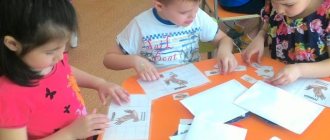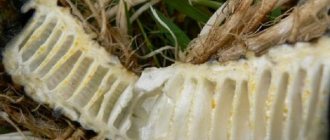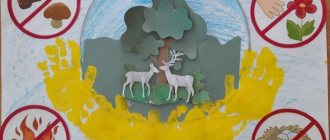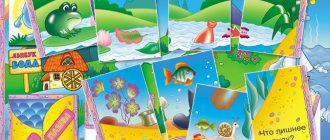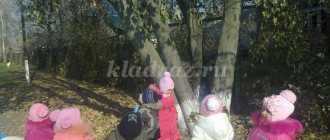Abstract of the OOD on environmental education “The World of Indoor Plants” in the senior group.
Abstract of OOD on environmental education
“The World of Indoor Plants” in the senior group.
Goal: expand children's knowledge about indoor plants
Tasks:
- Strengthen the ability to recognize familiar plants and name their parts;
- Tell us about professions related to caring for indoor plants
- To consolidate knowledge about the basic needs of indoor plants, taking into account their characteristics
- Improve plant care skills
- Develop a desire to help adults care for plants
- Replenish children's vocabulary (ficus, violet, aspidistra, clivia)
- Develop imaginative perception, imagination, creativity
- Foster a caring attitude and love for nature; desire to care for plants.
Amount of children:
whole group
Location:
group room preschool educational institution
Preliminary work:
looking at indoor plants, looking at illustrations on the topic “House Plants”, carrying out work assignments
Materials and equipment:
Multimedia projector, laptop, slides with images of indoor plants, diagrams on the topic.
GCD move:
Q: Hello guys, today I want to talk to you about a very interesting topic, but first, guess the riddle.
Purify the air
Create comfort
The windows are green,
They bloom all year round.
(Houseplants).
That's right, today we will talk about indoor plants. Do you have them at home? Which ones? (answers)
Do we have them in our group? Let's take a look at them. The flowers remained green both in winter and summer. Maybe the flowers are not real, but artificial? Prove that this is not so. What signs of living things do you know? (growth, nutrition, breathing).
— Do flowers grow? What and with what help do they feed? (water, nutrients from the soil via roots).
- Breathe: absorb carbon dioxide and release oxygen (purify the air). Air is also needed for roots (loosening).
—Can flowers move? (turn to the sun).
— What conditions are necessary for plant growth? (light, heat, moisture).
For plants to grow well, they must be kept clean. Why? (Flower leaves must be clean to breathe well)
You guys are so great! You know even more than me.
Or maybe you can also tell us what parts plants have?
Didactic game “Show and name the parts of the plant”
The teacher shows the parts of the plant: root, stem, leaves, flower.
Q: And now I invite you to be little plants. Sit down on the carpet.
(physical education minute)
I will plant a seed in a small pot (squat down)
A thin stalk will grow from the seed (stands up quietly, hands up)
And then the leaves (arms to the sides, forward, alternately)
Program content. Clarify and systematize children's knowledge about plants. Teach children to more fully describe plants, noting significant features of appearance. Introduce more precise definitions of the appearance of individual parts of plants into the children's dictionary: curly trunk, rough leaves, leaf edge with teeth, etc. Introduce children to a new plant - abutilon (indoor maple), note the characteristic features of its appearance. Strengthen children's interest in caring for and observing plants.Preparing for the lesson. On the teacher’s table there are plants: fragrant and zonal geranium, indoor grapes, primrose, fern. Abutilone was removed at the beginning of the lesson.
Progress of the lesson.
The children are sitting in their places. The teacher says: “Children, today we will look at some of our indoor plants and talk about them. What are the names of the plants that stand on the table? (Children call.) Let’s first look at indoor grapes.”
To make it easier for children to describe the first plant, the teacher asks questions: “What size are the grapes? What does it look like, a tree or a bush? (For a bush, it has several long trunks.) What kind of stem does the grape have, straight or not? (Its stem is not straight, it curls around the bar.) Correct. That's what it's called - curly. How do the grapes cling to the bar? Yes, he has a mustache. What are they, what are they like? Right. On springs, with them the grapes cling to the support. What kind of leaves do grapes have? Tell me, Raya. (Large, dark green, dense, oval-shaped, the edge of the leaf has teeth.) Stroke the leaf: what is it like? (Smooth.) Are the grapes blooming? (No, it didn’t bloom here.)”
The teacher calls one child and asks him to tell him everything about the grapes that the other children noticed and said.
In a corner of nature, children work with interest: preparing the ground for sowing seeds, planting cuttings, and caring for planted plants.
After this, primrose and fern are examined. The teacher invites the children to talk about these plants in the same way as they talked about indoor grapes; If someone is at a loss, help him with a question or invite another child to continue the story.
Then the teacher says: “Now let’s compare two plants. Are primrose and fern similar? (No, they are not alike.) Look at them carefully and tell me how they are not alike. What kind of leaves do they have? (The leaves of the primrose are round, not smooth, rough, dense, the edge of the leaf is even, but the leaves of the fern are long, smooth, thin, cut out at the edges; the young leaf of the fern is curled at the end.) Look at them again carefully and say what they are similar. How big are both plants? (Small.) What color are their leaves? (Light green.) That's right, that's how they are similar, but what else? Do they have a visible stem? (No, both the primrose and the fern have no visible stem.) This means that both plants are not only different from each other, but also somewhat similar to each other.”
Then the teacher offers to look at two different geranium plants, asks to compare them and note how they are similar and how they differ. Children talk.
“Now I’ll show you a new plant,” says the teacher and brings in abutilone. “It’s called indoor maple.” Look at it carefully and tell me why it is called that. That's right, its leaves look like the leaves of a maple tree. Tell us about it the same way you talked about other plants. (Children talk.) Indoor maple grows well in a bright place. Where do you think he should stand in our group? That's right, the sun often falls on this window, after class we will put it here. It needs to be watered more often. And now we will play with you. I will ask questions about plants, and you will answer. Which plant has the largest leaves? What about the little ones? Which of our plants blooms in winter? Which ones started to bloom in the spring? How do plants' leaves unfold? Which plant has a leaf “dressed in a shirt”? (In ficus.) Which plant has a young leaf that is first rolled into a light green tube, and then it unfolds and darkens? (In a friendly family.) Which plant has the tip of a young leaf curled up like a snail? (At a fern.) Which plant has a scent not only for its flowers, but also for its leaves? (Geraniums.) Which plants have bright red flowers? What about the whites? And the pink ones? Which plants have large single flowers, and which have many small ones? Now come up with your own questions about the plants of this corner of nature.”
Children learn to ask similar questions, the teacher helps them, paying attention to the characteristic features of the plant’s appearance, its size, etc., praises those who came up with interesting questions, emphasizes that all the children’s questions indicate that they love plants and carefully observe their growth and development.
At the end of the lesson he summarizes: “You studied well today, you spoke correctly about plants, you saw a lot of interesting things in them. Continue to observe our plants; If any of you see anything new from them, tell everyone.”
At the beginning of the year, it is advisable to offer children simpler plants to examine and describe, then you can give them more complex ones. At the end of some classes on getting to know plants, educational games such as “Guess by Description” are also used. The teacher makes a wish for a plant, and the children guess. “The plant is large, the stem is not visible, the leaves are narrow, dense, dark green, smooth, the leaf edges are even, the flowers look like orange bells, they are all collected on one arrow,” says the teacher. “What kind of plant is this?” (Clivia.) Now you guess, and I’ll guess.”
It is important to remember the following: when children learn to describe a plant in class, its description should begin with the most noticeable part (flowers), and when the teacher describes a plant during a game, the most noticeable features are mentioned at the very end of the description.
When describing plants, the teacher helps children note the characteristic features of each of them with questions.
In these classes, children learn to carefully examine and describe their plants. If during the lesson the children cannot answer one or another question about a plant, the teacher does not need to rush to answer it himself; After the lesson, children should be asked to think about what plant this is said about, and after a while ask if they guessed what plant the question was about.
In addition to similar activities, you can conduct one that is entirely devoted to a didactic game, for example, “Flower Shop,” where children practice their ability to describe plants and guess them from the description.
While examining plants (in and outside of class), the teacher should draw the children’s attention to the appearance of the plant, emphasizing its attractiveness and how it decorates the group. For example, ask which plant is the most beautiful; invite children to talk about it, note why it is attractive; find the most beautiful plant, examine it in order to draw it in the next lesson, analyze the drawings and note how the children managed to reflect the characteristic features of nature in their drawings, ask why geranium is called fragrant, and begonia is called ever-flowering.
Plants that should not be grown in a child's room
The appearance of some plants can cause fear in a child
In addition to useful plants, there are many other decorative and beautifully flowering indoor flowers that are prohibited from growing in rooms where children are present. And they are considered prohibited due to their dangerous substances found in the foliage of the potted flowers themselves. By breaking off a leaf of such a plant and chewing it, you can get poisoning or an unwanted allergic reaction that will appear on the child’s skin in the form of rashes.
Poisonous plants
All kids love to learn new things, they are interested in: what, how and why. Some plant leaves contain poisonous sap, which can cause serious poisoning and allergic reactions.
List of poisonous plants:
- nightshade - after flowering, huge, attractive berries are formed in place of the bolls, which are poisonous to humans
- alocasia – the leaves contain hydrocyanic acid and alkaloids
- oleander is a beautifully flowering plant characterized by the fact that all vegetative parts contain juice that is poisonous to humans
The above plants are not recommended to be grown in children's premises, as well as:
Dieffenbachia
Bush and tall species of Dieffenbachia cannot be grown not only in nurseries, but also in preschool educational institutions
Dieffenbachia is considered the most poisonous indoor flower, since the juice of the leaves is very poisonous. In ancient times, slaves were forced to chew Dieffenbachia leaves in order to make their voices disappear and they could not say anything.
The poisonous juice gets on the skin and causes a severe burning sensation. And if the child also rubs his eyes with his hand, it will be impossible to do without medical help.
Plants that can injure children
If tall species of sansevieria are prohibited for cultivation in children's rooms and in children's institutions, it is recommended to pay attention to low-growing varieties, for example, the sansevieria variety Honey
Many people like the inhabitants of dry areas - cacti and succulents. If for an adult these are wonderful plants that do not require close care, then for children they can cause great harm, since they have sharp thorns.
In addition to cacti, you should be careful when growing plants with long leaves, such as sansevieria or mother-in-law's tongue. This is undoubtedly a useful plant, but long leaves can play a cruel joke. The fact is that a child, crawling around the house, can stand on his feet and reach a plant standing on the table, pull a beautiful long leaf and throw a large pot onto himself from the table. To avoid injury, you should not grow the plant in your baby’s room, especially since the leaf is very sharp and can cause injury.
Plants that cause fear
Sundew is a “scary” plant for children. God forbid a child sees it swallowing an insect. The baby will have an insurmountable fear that someday this plant will bite him too.
It's no secret that childhood is a time of all sorts of imagination and imagination. Therefore, you need to be extremely careful when choosing plants. You can buy a completely harmless plant that only brings health benefits, but it will have intricate foliage that can frighten a child.
It is not recommended to buy tall palm trees and vines for the children's room. These include: monstera, dracaena, scindapsus, philodendron. The named flowers, after they grow, on a sunny day can cast terrible shadows in which children can see, thanks to their imagination, terrible monsters and monsters.
Plants that cause allergies
It is believed that hydrangea with exotic flower colors can cause allergies. However, before throwing this flower away, you need to check whether this is actually the case. After all, not all people have a plant that can cause a similar reaction.
Indoor potted flowers that cause irritation to the mucous membranes and skin:
- hydrangea
- azalea
- pelargonium
Having named the list of plants prohibited for cultivation due to the fact that they cause allergic reactions, it is necessary to make a reservation that these plants are beneficial to health, therefore, before throwing them aside, it is recommended to check whether you are allergic to them or not. If there are no signs, the plants can be grown.
But azalea is considered a poisonous plant, the juice of which can cause severe allergies. Therefore the flower is not recommended.
The world of flowers is a wonderful world that not only helps to purify the air and improve the atmosphere at home, thanks to the beauty and variety of potted flowers, you can introduce a child to the world of beauty, show how plants live, grow and reproduce, and teach a child to work. By caring for plants, kids acquire the skills of responsibility for all life on Earth. They learn that everything needs care and that only work and perseverance will help preserve the beauty of the living world.
